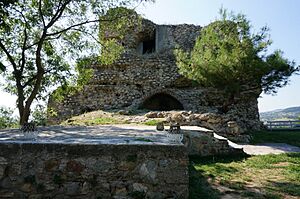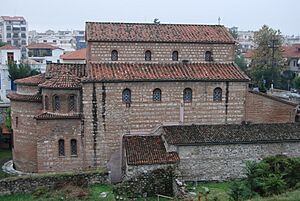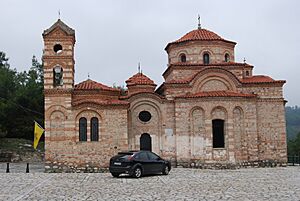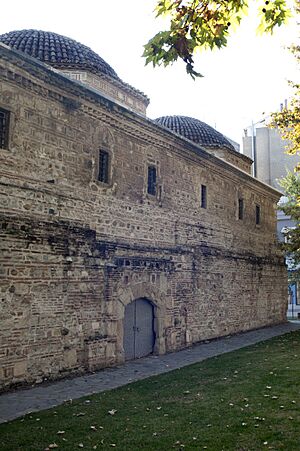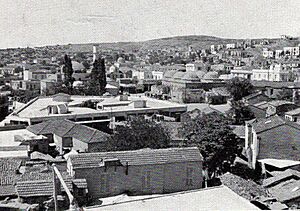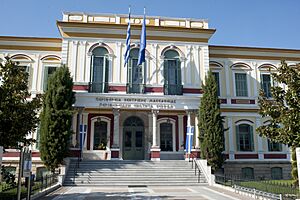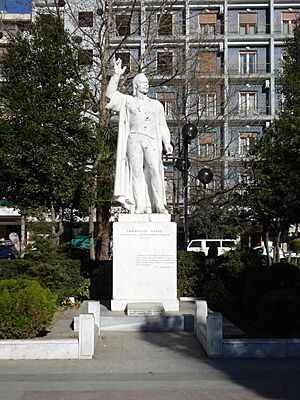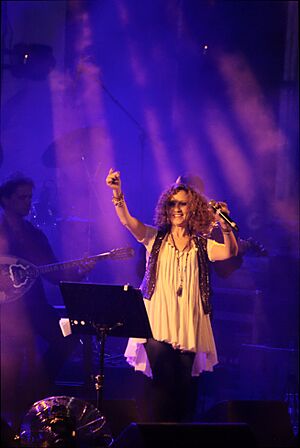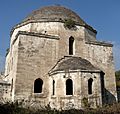Serres facts for kids
Quick facts for kids
Serres
Σέρρες
|
||
|---|---|---|
|
Clockwise from top: Saints Theodoroi Church, Serres Acropolis, Serres Prefecture Building, Archaeological Museum of Serres, Lake Kerkini, Emmanouel Pappas Statue and Sarakatsani Folklore Museum
|
||
|
||
| Country | Greece | |
| Geographic region | Macedonia | |
| Administrative region | Central Macedonia | |
| Regional unit | Serres | |
| Area | ||
| • Municipality | 600.5 km2 (231.9 sq mi) | |
| • Municipal unit | 253.0 km2 (97.7 sq mi) | |
| Elevation | 50 m (160 ft) | |
| Population
(2021)
|
||
| • Municipality | 70,703 | |
| • Municipality density | 117.740/km2 (304.946/sq mi) | |
| • Municipal unit | 60,888 | |
| • Municipal unit density | 240.66/km2 (623.32/sq mi) | |
| Demonym(s) | Serrean (Greek:Serreos) |
|
| Community | ||
| • Population | 59,260 (2021) | |
| Time zone | UTC+2 (EET) | |
| • Summer (DST) | UTC+3 (EEST) | |
| Postal code |
621 xx
|
|
| Area code(s) | (+30) 2321 | |
| Vehicle registration | ΕΡ | |
| Website | www.serres.gr | |
Serres (Greek: Σέρρες [ˈseɾes]) is a city in Macedonia, Greece. It is the capital of the Serres regional unit. It is also the second largest city in Central Macedonia, after Thessaloniki.
Serres is an important center for government and business in Northern Greece. The city is in a rich, flat area about 70 metres (230 feet) above sea level. It is about 24 kilometres (15 miles) northeast of the Strymon river. Serres is also about 69 km (43 mi) northeast of Thessaloniki. In 2021, Serres had an official population of 70,703 people.
The city is home to parts of two universities. These are the Department of Physical Education and Sport Science of the Aristotle University of Thessaloniki. Also, the Serres Campus of the International Hellenic University is here. This campus includes departments for engineering, economics, management, and interior design.
Contents
- City Names Through History
- Serres Through Time
- City Government
- Weather in Serres
- Serres Economy
- Fun Places to Visit
- Local Culture
- Delicious Local Food
- City Areas
- Getting Around Serres
- Population Numbers
- Famous People from Serres
- Motor Sports in Serres
- Higher Education
- Sports Teams
- City Partnerships
- Images for kids
- See also
City Names Through History
The ancient Greek historian Herodotus called the city Siris (Σίρις) in the 5th century BC. Another historian, Theopompus, called it Sirra (Σίρρα). Later, the Roman historian Livy used the name Sirae, which is plural.
By the 5th century AD, the name became Serrae or Sérrai (Σέρραι). This plural form has stayed the same until modern times. In the local Greek language, people still call it "ta Serras." This name comes from an older plural form.
The city was known as Serez or Siroz in Turkish. In Slavic languages, it is called Ser (Сер) in Macedonian. In Bulgarian, it is Syar (Сяр) or Ser (Сер). In Aromanian, Serres is known as Siar or Nsiar.
Serres Through Time
Ancient Beginnings
The city of Serres, first called Siris, was mentioned in 5th century BC. But it was actually founded much earlier, possibly around 2000 BC. The ancient city was built on a tall hill called "Koulas" north of modern Serres.
This location was very important. It controlled a land route along the Strymon river valley. This road went from the Strymonian Gulf all the way to countries near the Danube river.
The first people known to live here were the Bryges (also called Phrygians) and Strymonians. Later, Paeonian tribes like the Siropaiones and Odomantes lived in the area. These groups mostly farmed and raised animals. They often worshipped the Sun, the Strymon river, and the "Thracian horseman."
Roman Times
During the Roman period (168 BC – 315 AD), the city was called Sirra. It was an important city in the Roman province of Macedonia. It grew especially strong during the time of peace known as Pax Romana.
Like other Greek cities, Sirra had a market (agora), a parliament (bouleuterion), a theater, and temples. The local government used Greek traditions with a parliament (boule) and elected officials.
Sirra was also the center of a group of five cities called the "Pentapolis." Many people from Serres became Roman citizens. They even held important positions in the Roman province.
The city of Sirra had its own land, which was similar to the modern province of Serres. This land had villages, and traces of them have been found near places like Lefkonas and Neo Souli. Marble quarries and iron mines were also found, showing that people used the area's natural resources.
Most people in Sirra were Greek. There were also some older groups from prehistoric times. People worshipped many gods, including Greek gods like Dionysus and Zeus. They also worshipped local gods like the Thracian horseman.
Many Roman-era writings have been found in Serres. Most of these are in Greek, with a few in Latin. They tell us about the city's history and people.
Middle Ages
The first known bishop of Serres was at a church meeting in 449 AD. Around 803 AD, Emperor Nikephoros I rebuilt the town. He placed a strong army there to protect it from Slavic tribes.
The city was mostly peaceful until the 10th century. Then, the Bulgarians attacked and briefly took over. In 1185, Normans attacked the area around the city. In 1195/6, the Byzantines lost a battle to the Bulgarian ruler Ivan Asen I.
After the Fourth Crusade, Boniface of Montferrat took Serres. But soon after, Kaloyan of Bulgaria defeated the Crusaders and captured the city. It was later taken back by the Crusaders in the early 1230s. Kaloyan's attack caused a lot of damage, making the city much smaller.
In 1246, the city returned to Byzantine rule. It was captured by the Nicaean Empire. By the 14th century, Serres had grown back to its former size and wealth. A writer called it a "large and marvelous" city.
During a Byzantine civil war (1341–47), the Serbs attacked and took the city on September 25, 1345. Serres became the capital of Stefan Dušan's Serbian Empire. Dušan rebuilt the city's fortress.
After Dušan died in 1355, his empire broke apart. Serres became its own small state. It was first led by Dušan's wife, Helena. After 1365, it was led by Despot Jovan Uglješa. He kept strong ties with the Byzantine court. Greek people played a big role in his government, which used the Greek language. After a battle in 1371, the Byzantines took Serres back.
Ottoman Rule
Serres fell to the Ottoman Empire for a short time in 1371. It was taken permanently on September 19, 1383. The city and its area became a special land given to Evrenos Beg. He brought in new settlers.
Old stories say that the people of Serres were allowed to keep their homes and churches. The Turks settled outside the old city walls. These walls were later torn down to prevent rebellions. The first mosque in the city was built in 1385.
In 1454/55, Serres had about 6,200 people. The number of Muslim residents grew steadily. By the end of the 15th century, the first Sephardi Jews arrived from Sicily and Spain.
In the early 16th century, a French traveler visited Serres. He said the town had mostly Greeks, along with German and Jewish communities. People in the countryside spoke Greek and Bulgarian. After a Christian victory in 1571, the Turkish rulers punished the Greek people who had rebelled. Churches were looted, and land was taken.
A priest named Synadinos wrote a lot about the town's history from 1598 to 1642. Other travelers also described Serres. They said it was a busy place with many Christian and Muslim neighborhoods. It had many mosques, schools, and baths. Serres also had a large market with many shops and inns.
In the 18th and early 19th centuries, Serres was a special self-governing area. It was known for producing cotton. This cotton was sent to countries like Germany and France.
A Greek school was founded in Serres in 1735. It was supported by rich Greek merchants. One of them was Emmanouil Pappas, a leader in the Greek War of Independence.
A big fire in 1849 destroyed most of the city's churches. Serres became a regular province around 1846. In the late 19th century, Serres was one of the most important towns in Macedonia. It had a mix of Muslims, Greeks, and Bulgarians.
The growth of railways and steamships made the city's famous annual fairs less important. Business slowed down. But Serres became important again when a railway connected it to Thessaloniki and Constantinople in 1896. By the late Ottoman rule, tobacco farming became more common than cotton.
In the early 1900s, the city became a center for people who wanted to break away from Ottoman rule. This led to an uprising in 1903. The Ottoman census of 1905 recorded 42,000 people living in Serres.
Modern Era
A Bulgarian army captured Serres during the First Balkan War in November 1912. But Greek forces, led by King Constantine I, took it back during the Second Balkan War. The first Greek officer to enter Serres was Colonel Napoleon Sotilis on July 11, 1913.
Before leaving, the Bulgarians set fire to the city. This burned down much of the old town and many newer areas. During the First World War, Serres was temporarily taken by the Central Powers. This happened after King Constantine ordered the local army not to fight. The city was later freed in 1917 by Greek and French forces.
During the Second World War, Nazi Germany took over Greece. Serres was given to their Bulgarian allies. They occupied the city until 1944. In 1943, the Jewish people living in Serres were sadly taken away from their homes. There was a strong resistance movement in the city during this time.
After the war, the city's population grew a lot. The quality of life also improved. The Greek Prime Minister Constantine Karamanlis was from Serres. This meant the city often had support from the government in Athens. However, people in the villages around the city were not as lucky. Low prices for farm products caused many to move away, mostly to the United States and West Germany.
As of As of 2015[update], the Mayor of Serres was Petros Angelidis.
City Government
The current Serres municipality was formed in 2011. It combined six smaller municipalities into one larger area. These smaller areas became municipal units of the new municipality.
The total area of the municipality is 600.479 km2. The main municipal unit of Serres covers 252.973 km2.
Weather in Serres
Serres has a hot summer Mediterranean climate. This means it has hot, dry summers and cool, wet winters. Rainfall is generally light throughout the year. July and August are the driest months.
Because Serres is inland, its summers are especially hot. Winters are cool but rarely very cold. The area gets nearly 2,600 hours of sunshine each year. The lowest temperature ever recorded in Serres was −23.0 °C (−9.4 °F) in January 1963. The highest was 44.6 °C (112.3 °F) in July 2007.
In June 2024, Serres had a very high average maximum temperature of 37.6 °C (99.7 °F). This was a record for Greece in June, shared with Sparta. In July 2024, Serres reached an average maximum temperature of 39.1 °C (102.4 °F), which is Greece's record to date.
| Climate data for Serres AWS, Hellenic National Meteorological Service 32 m a.s.l. | |||||||||||||
|---|---|---|---|---|---|---|---|---|---|---|---|---|---|
| Month | Jan | Feb | Mar | Apr | May | Jun | Jul | Aug | Sep | Oct | Nov | Dec | Year |
| Record high °C (°F) | 20.5 (68.9) |
23.4 (74.1) |
28.4 (83.1) |
33.4 (92.1) |
37.5 (99.5) |
41.3 (106.3) |
43.7 (110.7) |
43.4 (110.1) |
39.9 (103.8) |
32.7 (90.9) |
27.7 (81.9) |
22.6 (72.7) |
43.7 (110.7) |
| Mean daily maximum °C (°F) | 9.9 (49.8) |
13.8 (56.8) |
17.3 (63.1) |
22.9 (73.2) |
27.8 (82.0) |
32.7 (90.9) |
35.9 (96.6) |
36.2 (97.2) |
30.7 (87.3) |
23.6 (74.5) |
16.8 (62.2) |
11.2 (52.2) |
23.2 (73.8) |
| Daily mean °C (°F) | 5.1 (41.2) |
8.3 (46.9) |
11.2 (52.2) |
15.6 (60.1) |
20.4 (68.7) |
25.0 (77.0) |
27.8 (82.0) |
27.8 (82.0) |
23.0 (73.4) |
17.0 (62.6) |
11.5 (52.7) |
6.5 (43.7) |
16.6 (61.9) |
| Mean daily minimum °C (°F) | 0.2 (32.4) |
2.8 (37.0) |
5.1 (41.2) |
8.2 (46.8) |
13.1 (55.6) |
17.4 (63.3) |
19.7 (67.5) |
19.4 (66.9) |
15.3 (59.5) |
10.4 (50.7) |
6.3 (43.3) |
1.7 (35.1) |
10.0 (49.9) |
| Record low °C (°F) | −10.8 (12.6) |
−7.5 (18.5) |
−6.0 (21.2) |
−1.4 (29.5) |
6.8 (44.2) |
10.1 (50.2) |
14.9 (58.8) |
13.3 (55.9) |
4.9 (40.8) |
1.7 (35.1) |
−4.1 (24.6) |
−7.0 (19.4) |
−10.8 (12.6) |
| Average precipitation mm (inches) | 50.8 (2.00) |
34.2 (1.35) |
48.9 (1.93) |
34.3 (1.35) |
57.8 (2.28) |
44.2 (1.74) |
27.0 (1.06) |
17.3 (0.68) |
42.5 (1.67) |
38.2 (1.50) |
44.8 (1.76) |
52.8 (2.08) |
492.8 (19.4) |
| Mean monthly sunshine hours | 106.0 | 115.4 | 168.7 | 181.6 | 237.4 | 274.5 | 309.9 | 302.3 | 223.0 | 176.5 | 101.3 | 106.5 | 2,303.1 |
| Source: Serres HNMS AWS (May 2011-Aug 2024), World Meteorological Organization | |||||||||||||
| Climate data for Serres (1971–2010) | |||||||||||||
|---|---|---|---|---|---|---|---|---|---|---|---|---|---|
| Month | Jan | Feb | Mar | Apr | May | Jun | Jul | Aug | Sep | Oct | Nov | Dec | Year |
| Mean daily maximum °C (°F) | 8.3 (46.9) |
11.0 (51.8) |
15.1 (59.2) |
19.9 (67.8) |
25.6 (78.1) |
30.3 (86.5) |
32.6 (90.7) |
32.2 (90.0) |
27.9 (82.2) |
21.5 (70.7) |
14.3 (57.7) |
9.1 (48.4) |
20.7 (69.3) |
| Daily mean °C (°F) | 4.2 (39.6) |
6.4 (43.5) |
9.9 (49.8) |
14.5 (58.1) |
20.0 (68.0) |
24.6 (76.3) |
26.8 (80.2) |
26.0 (78.8) |
21.7 (71.1) |
16.0 (60.8) |
9.7 (49.5) |
5.2 (41.4) |
15.4 (59.7) |
| Mean daily minimum °C (°F) | 0.0 (32.0) |
1.3 (34.3) |
4.1 (39.4) |
8.0 (46.4) |
12.9 (55.2) |
16.9 (62.4) |
18.9 (66.0) |
18.2 (64.8) |
14.5 (58.1) |
9.9 (49.8) |
4.9 (40.8) |
1.2 (34.2) |
9.2 (48.6) |
| Average precipitation mm (inches) | 34.6 (1.36) |
37.7 (1.48) |
32.6 (1.28) |
38.5 (1.52) |
47.3 (1.86) |
40.7 (1.60) |
27.6 (1.09) |
26.8 (1.06) |
29.1 (1.15) |
43.0 (1.69) |
48.8 (1.92) |
55.4 (2.18) |
464.2 (18.28) |
| Average precipitation days | 7.9 | 8.0 | 8.2 | 8.9 | 9.7 | 7.1 | 5.2 | 5.1 | 5.1 | 6.5 | 8.2 | 9.3 | 89.2 |
| Average relative humidity (%) | 77.1 | 71.7 | 68.1 | 63.2 | 59.8 | 53.8 | 51.7 | 54.5 | 59.5 | 69.6 | 76.8 | 80.2 | 65.5 |
| Mean monthly sunshine hours | 98.4 | 111.4 | 147.4 | 191.6 | 237.5 | 293.9 | 316.5 | 294.7 | 236.3 | 169.0 | 106.8 | 85.9 | 2,289.4 |
| Source: Serres SYNOPTIC station, Hellenic National Meteorological Service | |||||||||||||
Serres Economy
Serres is the main city in an area that mostly focuses on farming. It is a key place for trading tobacco, grain, and livestock (farm animals).
In recent times, a government-supported manufacturing area has grown. This has made Serres a center for making textiles (cloth) and other products. Various foods, like meat and dairy, are also produced from animals raised near Lake Kerkini.
Fun Places to Visit
- Serres Public Regional Theatre
- Archaeological Museum of Serres (located in an old Ottoman market building)
- Serres Ecclesiastical Museum (about church history)
- Sarakatsani Folklore Museum (about the Sarakatsani people's traditions)
- Lake Kerkini (a beautiful lake near the town)
- Mehmet Bey Mosque (an old mosque)
- Hadzilia Folklore and Ethnological Museum
- Serres Racing Circuit (a race track)
- Saints Theodore Tyro and Theodore Stratelates Church, Serres (a historic church)
Local Culture
The Ottoman writer Omer Seyfeddin wrote a story called White Tulip (Beyaz Lale). It takes place in Serres during the First Balkan War.
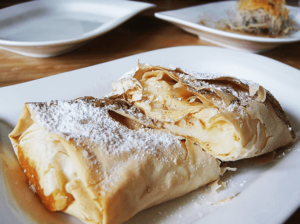
Delicious Local Food
The most famous food from Serres is probably bougatsa. This is a pastry often filled with cream or cheese. You can also find gyros and souvlaki in many restaurants.
A special sweet treat unique to the area is Akanés. This is a type of gourmet candy. It has been made using a secret recipe by the Roumbos family since the early 1900s. Another popular dessert is Poniró, which is similar to an Italian pastry called sfogliatella.
City Areas
- Katakonozi is a growing and successful part of the city.
- Kamenikia is an old neighborhood in the western part of Serres.
- Taxiarches (Center)
- Kallithea
- Agios Panteleimon
- Agios Antonios
- Kiouplia
- Omonoia - Kalyvia
- Agios Nikitas
- Ionia (Sfageia)
- Saranta Martyres
- Profitis Ilias
- Siris (Sigis / Nea Kifisia)
- Agioi Anargyroi
- Timiou Stavrou
- Agios Athanasios
- Makedonomachon
- Vyzantio (Kalkani)
Getting Around Serres
Road Travel
The European road ![]() E79 runs near Serres. It connects the city to Thessaloniki and the border with Bulgaria at Promachonas.
E79 runs near Serres. It connects the city to Thessaloniki and the border with Bulgaria at Promachonas.
The local KTEL bus system handles transport within Serres. The Intercity KTEL connects Serres to other cities in Macedonia and the rest of Greece.
Train Travel
The train station is located outside the city. It is on the Thessaloniki-Alexandroupoli Line. You can take local and regional trains to Thessaloniki and Alexandroupolis.
Population Numbers
| Year | Municipal unit | Municipality |
|---|---|---|
| 1981 | 46,317 | – |
| 1991 | 49,830 | – |
| 2001 | 56,145 | – |
| 2011 | 58,287 | – |
| 2021 | 59,260 | 70,703 |
Famous People from Serres
- Christos Aritzis (born 1984), a football player
- Gazi Husrev-beg (1480–1541), an important leader in the Ottoman Empire
- Halil Rifat Pasha, a Grand Vizier (high official) of the Ottoman Empire in the 19th century
- Hoca Ibrahim Pasha, Grand Vizier of the Ottoman Empire in 1713
- Emmanouel Pappas, a leader in the Greek War of Independence in Macedonia
- Konstantinos Karamanlis (1907–1998), a very important Greek politician. He was Prime Minister of Greece four times and President twice. He was born near Serres.
- Efstathios Tavlaridis, a football player
- Doukas Gaitatzis, a leader in the Macedonian Struggle
- Demetrius Hondros, a physicist
- Vicky Kalogera (1971), an astrophysicist and professor
- Giorgos Kapoutzidis (1972), a scriptwriter and actor
- Glykeria, a famous singer
- Stratos Dionysiou (1935–1990), a singer
- Angelos Charisteas, a football player
- Maria Houkli, a journalist
- Anna Spyridopoulou, a basketball player
- Kostas Tsimikas, a football player
- Christos Xenitopoulos, a football player
- Dimitrios Psaltis (1970), an astrophysicist and professor
- Panos Ipeirotis, a computer scientist and professor
Motor Sports in Serres
Serres is well-known for motor sports. The Serres Circuit was built in the city in 1998. It was designed for races up to Formula 3. This racetrack is the biggest in Greece. It meets the rules of the International Automobile Federation and the International Motorcycling Federation. The track is owned by the Municipality of Serres.
Higher Education
Serres is home to the Technological Educational Institution (TEI) of Central Macedonia. This school has over 14,000 students studying for bachelor's and master's degrees. It has three main departments and many smaller ones. In 2012, it started offering master's programs in English. In 2019, this TEI joined with the International Hellenic University.
There is also a Department of Physical Education and Sport Science from the Aristotle University of Thessaloniki in Serres. It offers degrees in sports and physical education.
Additionally, the Vocational Training Institute (Greek: Ι.Ε.Κ.) in Serres offers various special training programs. These programs usually last up to two years.
Sports Teams
Serres has a sports club called Panserraikos. It is a football (soccer) club that plays in the second national division.
| Club | Founded | Sports | Achievements |
|---|---|---|---|
| Panserraikos | 1964 | Football | Earlier presence in A Ethniki |
City Partnerships
Serres has "twin city" relationships with other cities around the world. This means they share culture and friendship.
Images for kids
-
Fresco in Prodromou Monastery near Serres, showing Emperor Andronikos II Palaiologos giving gifts to the monastery
See also
 In Spanish: Serres (Grecia) para niños
In Spanish: Serres (Grecia) para niños











